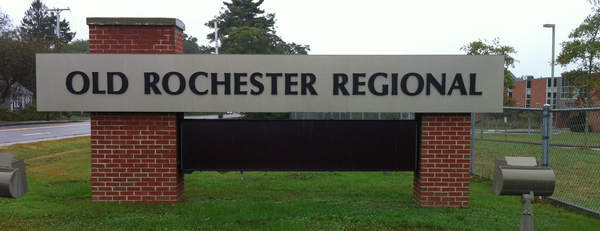Breaking down the ORR budget debate
When it comes to the very large and always growing Old Rochester Regional budget, one thing is for certain: The School Committee and tri-town selectmen do not agree on numbers.
The bulk of the problem appears to stem from salaries and the increasing cost of insurance benefits (for current and retired employees), which account for 61 percent and 21 percent of the budget, respectively.
First, some background. The original draft of the junior high and high school budget proposed an almost $835,000 increase above the current budget, a 4.7 percent increase. Tri-town selectmen and other town leaders balked at that figure, noting that the towns’ tax base can only increase by 2.5 percent a year, per state limits, in addition to new revenues. That’s in the neighborhood of $400,000 a year for each town.
The towns told the School Committee it would only receive a $382,000 increase.
Why was the proposed increase so significant?
Marion Selectman Jody Dickerson called the proposal a “wish list” and said, “I don’t know where this money was going to come from.” ORR School Committee Chair Tina Rood said the amount accounted for “increases that were contractually required as well as those items that, as a committee and the administration, we felt were needed to move the school forward.”
The School Committee said only increasing the budget by $382,000 would jeopardize the education at the school and result in several positions being removed from the budget, namely the junior high music teacher and a high school technology teacher.
To maintain the same level of service as the current budget, the committee voted to increase the number of school choice slots from 68 to 125. The school choice program allows a district to accept students from other towns in exchange for a $5,000 reimbursement from the sending community.
But the school choice solution is only a patch, and selectmen and School Committee members agree that changes need to be made going forward.
Salary increases
The largest point of contention between the School Committee and selectmen is over salaries.
Last spring, teachers and the School Committee finalized a three-year contract that gives teachers a 2 percent increase each year. But, selectmen have said that many teachers received a 3 or 4 percent increase. Where’s the disconnect?
The contract does give teachers a 2 percent raise across the board, but they also receive salary increases for “steps and lanes.” There are 12 steps that roughly correspond to a teacher’s first 12 years of teaching and come with pay increases. Teachers also move to different lanes as they increase their education. That’s nothing new, says Colin Everett, the president of the teacher’s union.
“Steps and lanes have been part of our salary schedule for over fifty years,” he said. “Steps are part of almost every educator contract. Municipal workers get steps, too.”
Last year, however, selectmen told the School Committee to limit raises to 2 percent.
“We just told them when you negotiate, do not do more than a two percent pay increase. That’s the bottom line,” said Marion Selectman Jody Dickerson.
Mattapoisett Selectman Paul Silva also said administrators receive more than 2 percent. Because the towns schools are not regionalized, central administrators receive salaries from each town in addition to ORR, which accounts for the largest percentage of their pay.
The proposed budget for next year, which has to be approved by town meeting voters, includes a 2.8 percent increase for the superintendent, who would make $101,465 through the ORR budget and 3 percent for the director of curriculum and school business administrator, who would make $65,905 and $65,858.
As an example, Silva said, “When you have somebody making $170,000 and add 3.2 percent to his salary, those are huge numbers. It’s substantially higher than what our town administrators are making.”
Insurance on the rise
Insurance rates are set to rise by an estimated 12 percent this year, and selectmen want teachers to pay more for it. For the previous teacher contract, faculty did move from paying 20 percent of their insurance to 30 and sometimes 35 percent.
Selectmen wanted all new employees to pay half.
If new teachers and the school split the insurance costs 50-50, it would have saved a lot of money and the new teacher wouldn’t have lost anything, said Silva.
Mattapoisett schools agreed on a 50-50 split for new hires several years ago, but ORR teachers didn’t want to take that route.
“Our theory is that if we’re going to work together, then that’s part of having a collaborative and productive work environment,” said Everett.
He said the negotiations of the previous contract did save the towns hundreds of thousands of dollars.
What’s next?
Rood is concerned about the lack of discussion in this year’s decisions and said the committee received an email with the $382,000 figure, end of story.
“It was just a number with no context of the impact on education. Just to have a discussion, is a helpful place to be,” she said.
Rood would like to see selectmen increase the towns’ tax bases, thereby providing enough growth to accommodate budgets for both school and municipal needs. Without that, she said everyone’s budget – the towns and schools – will continue to suffer. She also acknowledged that it is a long-term solution.
Dickerson also believes there wasn’t enough discussion.
“I wish that the School Committee was more involved with us working on the budget, know what’s going on in other departments as well,” he said.
Mattapoisett selectmen have suggested the three towns hire a third-party to evaluate ORR’s finances as well as look at issues such as funding retiree insurance, a major liability for both the school and municipalities. It’s too soon to know yet whether the three towns will agree to fund an outside advisor.
In the meantime, Rood said, “We agreed to the number that they gave us.”
She plans to speak with her committee soon about working more effectively with town leaders.
“We still need to sit down and talk about long-term in a positive and cooperative way,” she said.
















